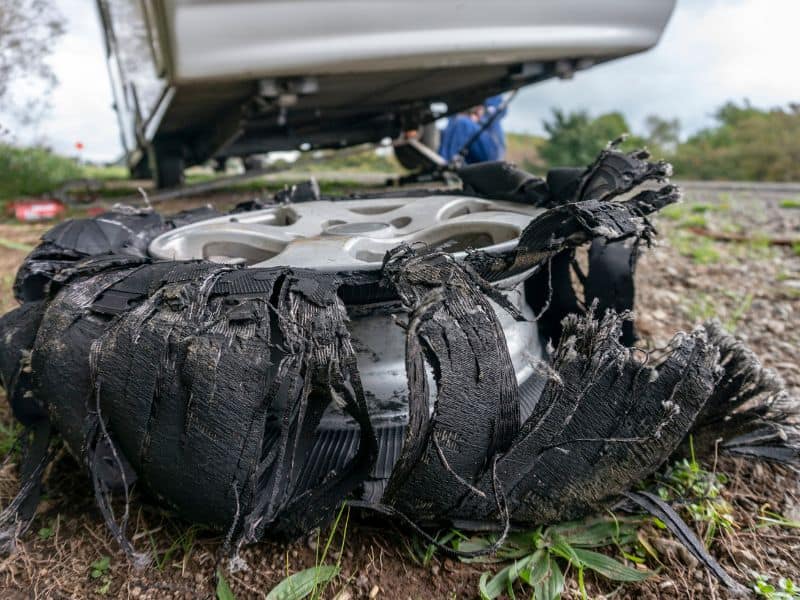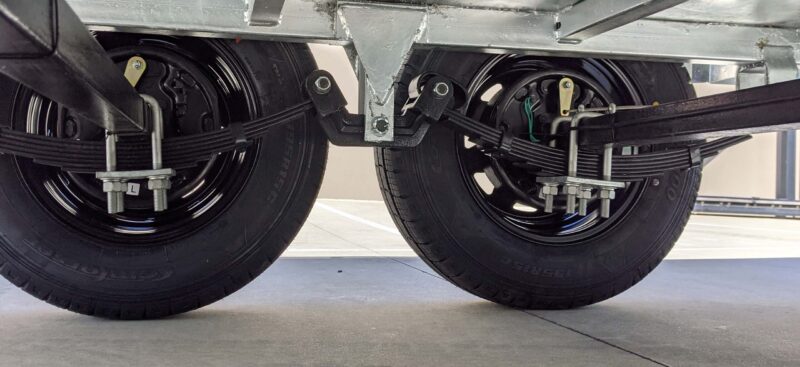No matter how many ways you attempt to avoid a flat tire, eventually, you will end up with one. Knowing how to jack up a travel trailer and safely change the flat can keep you traveling with minimal interruptions.
However, many travel trailer owners are not prepared to fix a flat on their trailer. In this article we will take a look at the ins and outs of how to jack up a travel trailer, making the task of changing a tire hassle-free.
Do Travel Trailers Have Spare Tires?
One of the first things you need to know before you have a flat tire is if your travel trailer has a spare tire. It does no good to know how to jack up your travel trailer if you do not have a spare tire.
When you are shopping for a travel trailer, you need to be aware that not all travel trailers come with a spare tire as a standard feature. This can be a surprise for many new owners, and sometimes a very inconvenient realization.
When shopping for a new travel trailer, make sure that you check for a spare tire on the model that you want. If there is not one, ensure you have one added before you drive off the lot.
If you already own your travel trailer, or if you are purchasing a used travel trailer, you may need to purchase a spare tire. Make sure that you purchase one that matches the tires and wheels on your travel trailer. This ensures a seamless transition to your spare tire.
Another bit of helpful information about spare tires – make sure that they are properly inflated. There is nothing more disappointing than successfully changing your tire only to find out your spare tire is flat as well.
We find that most camper trailer owners forget to inflate the spare tire when they inflate their active tires which leaves them with a flat or low spare when they need it most!
Do Travel Trailers Come With Jacks?
Jacks for travel trailers are one of those must-have accessories that owners need to purchase on their own. You will rarely find a travel trailer that comes with jacks, even if it has a spare tire.
If you are shopping for a jack for your travel trailer, you will need to carefully research the proper size for your trailer. Jacks are rated based on the amount of weight they can lift.
You will need to know the GVWR of your travel trailer when considering a proper jack. The GVWR includes the weight of the trailer plus the weight of your gear.
The other feature of a jack that you need to consider when selecting one for your travel trailer is the height. Look for a jack that extends high enough to lift your travel trailer. This may mean that you will need to use lifting blocks, particularly if you have a larger travel trailer.
It is usually not a good idea to try and use the jack that comes with your tow vehicle. It may work in a pinch, but typically, these jacks are not made to hold up a travel trailer. They may have enough weight capacity, but they may not be sturdy enough for your travel trailer.
Can You Change A Tire On A Camper Trailer Yourself?
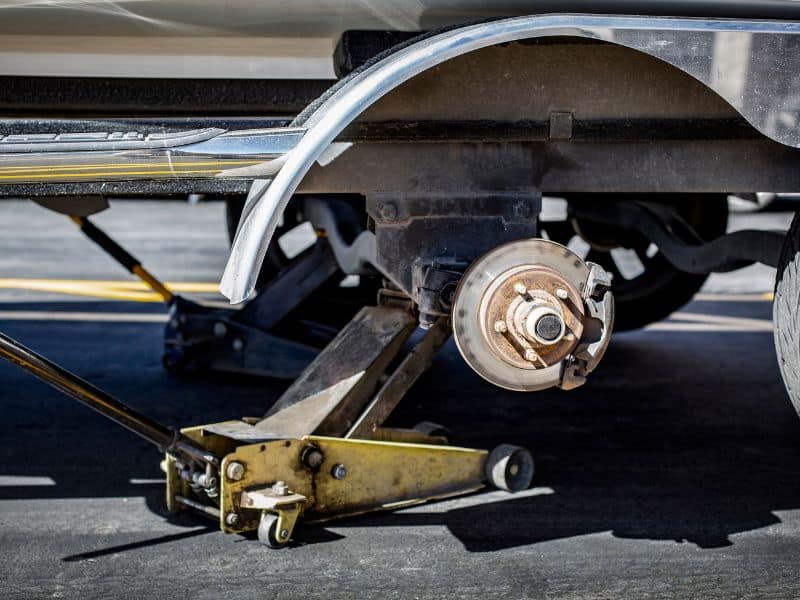
One of the most important things you can do as a travel trailer owner is to know how to do basic and important maintenance and repair tasks. One of the first things you should do as a travel trailer owner is learn how to change the tires on your trailer.
You should never learn how to do this task on the road. Learning how to change a tire on your camper before you hit the road is safe and low-pressure. Take time to practice at home. This will allow you to work out the kinks so that when you are on the side of the road you are prepared.
If this is something that you have never done before, ask for help. A skilled mechanic or the repair staff at your local RV dealership can help you learn how to change a tire.
Improperly changing the tires on your travel trailer can be very dangerous. Even if you are in a challenging location, you need to work carefully and ensure that you are taking the time to do the process correctly.
Rushing through changing a flat tire can be dangerous and result in an accident, or damage to your camper or tow vehicle.
What Tools Do You Need To Jack Up A Travel Trailer?
If you are new to jacking up your travel trailer to change a tire, it is helpful to know the basic steps before you practice. Jacking up your travel trailer is not a difficult task if done properly. Before you start traveling, you should be familiar with the steps below, and make sure you have the right tools.
- Spare tire – Make sure that your spare tire is the right size and is properly inflated before traveling.
- Trailer jack – Properly sized for your travel trailer. A jack that is a bit larger than necessary is better than a jack that is too small.
- Jack blocks – these are helpful if you are on a slope or need to have a little extra lift.
- Lug wrench – Before traveling, confirm that the lug wrench you have fits the lugs on your travel trailer wheels.
- Torque Wrench – Find the manufacturer’s torque spec. Torque each nut following the star tightening pattern.
- Wheel chocks – You should have wheel chocks as part of your normal safety equipment.
- Reflective triangles or cones – These are particularly helpful if you have to pull off the side of the road. These will tell other drivers to slow down and use caution when passing your travel trailer. In some states, not using these sorts of safety equipment can land you a traffic ticket.
- Gloves – Gloves will give you extra grip. This is helpful if it is raining or cold outside. They also keep you from getting road grime all over your hands.
- Flashlight – It never fails that a flat tire happens at night. A flashlight will allow you to see what you are doing so you do not have to struggle with a relatively simple task.
Now that you have the proper tools, you can easily jack up your travel trailer and change a flat tire. Here are the steps that you will take to properly jack up your travel trailer when changing a tire.
How To Properly Jack A Travel Trailer To Change A Tire
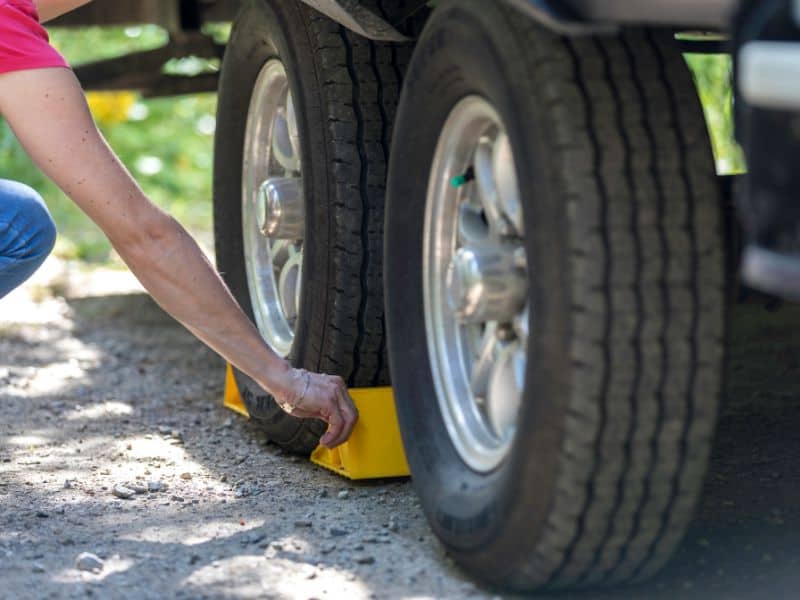
This is the normal process for jacking up a travel trailer to change a tire. This process works great for both single and double-axle trailers.
For those with double-axle trailers, there is a cool new product, called an EZ Jack, that allows you to jack up your travel trailer without the jack. These are good alternatives, just make sure that you know how to do the full process, just in case you are in a spot where you cannot use the EZ Jack.
- Get off the road – Pull off the side of the road, as far off the shoulder as possible. If possible, make sure that your stopping point is flat and smooth.
- Hazard Lights – Turn on your hazard or 4-way flashers before you exit your tow vehicle. This will alert other drivers that you are having trouble.
- Make yourself visible – Set a safe work zone using cones or reflective triangles. Many travel trailer owners do not carry cones or triangles. These are essential in our opinion. Having four or five cones or triangles allows you to set a long, safety zone and allow drivers to slow down and avoid you.
- Secure your trailer – Use wheel chocks on the opposite side of the trailer. Some people will tell you to do this after you break the lug nuts. Do this before you start. It will help you avoid “forgetting” these important safety tools.
- Break the lug nuts loose – You will want to do this before you jack up the trailer. The ground will hold the wheel in place. If you are having a difficult time breaking the lug nut loose, a helpful hint is to carefully jump on the lug wrench handle.
- Set the jack – Place the jack on a flat surface and the jack below the frame of the trailer. You may need to use jack blocks if the ground is uneven or if you have to work on a slope.
- Begin jacking – Carefully begin working the jack so that it connects with the frame of the travel trailer. Continue raising the jack until the tire is just slightly elevated off the ground.
- Remove lug nuts – You should be able to do this process with just your hands. However, the lug wrench may make the process faster. Set the lug nuts in a safe yet convenient location. You don’t want to lose them but putting them far out of the way is not helpful.
- Remove the flat/damaged tire – Carefully slide the wheel off the lugs away from the axle. Set the flat tire away from your working area.
- Install the spare tire – Carefully slide the wheel over the lugs. You may need to increase the height of the jack if you did not raise the trailer enough for the inflated spare tire.
- Replace the lug nuts – Tighten each one until they are snugged up against the wheel. Tighten in a star pattern.
- Lower the jack – Slowly release the jack returning the tires to the ground.
- Torque the wheels – Using your torque wrench tighten the lug nuts to the proper torque value.
- Clean up – Pack up all your tools and remove the jack and chock blocks from under the trailer. The last things you should return to your travel trailer or tow vehicle are the cones or reflective triangles.
- Hit the road – Turn off your hazard lights, and pull back onto the road, watching for other drivers.
- Double-check – At your first stop double-check the wheel and tire to make sure everything is as it should be.
Do You Need To Torque Travel Trailer Wheels?
When you are changing a tire, whether, on your travel trailer or your tow vehicle, you will want to torque the lug nuts. Torquing the lugs will ensure that the nuts are tightened appropriately.
The torque value will depend on the type of wheels that are on your travel trailer. Steel and alloy wheels, which are the most common on travel trailers will have different torque values.
Over-torquing lug nuts may seem like an OK idea. However, you can damage the wheels by over-torquing. This also makes it more difficult to remove the lug nuts the next time you need to change a tire.
Under torquing can cause the wheel to loosen while traveling. This can create a dangerous condition that may cause an accident or damage the travel trailer or your tow vehicle.
A good routine to add to your pre-travel maintenance is to check the torque of all the lug nuts on the wheels of your travel trailer. Properly torqued wheels can also reduce the likelihood of uneven wear on the tires.
Why Do Camper Trailers Have Tire Blowouts So Often?
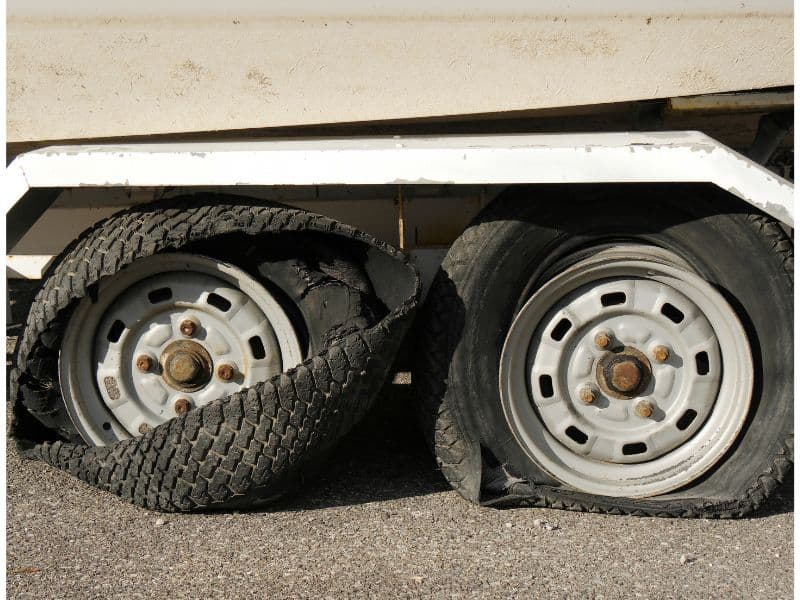
So, you might be wondering why it is so important to know how to jack up your travel trailer and change a tire. Well, campers and travel trailers tend to have blowouts more often than tow vehicles or motorhomes.
Some of the reasons for this higher incidence of flats and blowouts have to do with the tires. Others are related to how you care for your travel trailer.
To avoid blowouts here are some hints for caring for your travel trailer tires:
- Make sure you equip your travel trailer with good-quality tires. With tires, you get what you pay for. Cheap tires will not handle the side wall stress as well as better quality tires.
- Know the proper inflation value for your tires. Do not over or under-inflate tires. This also leads to wear issues and reduces the life of the tire.
- Replace your tires when they start showing signs of wear. Old tires are more likely to be dry, brittle, and weak. This increases the risk of blowouts.
- Finally, traveling at a reduced speed will greatly decrease your risk of a blowout. Even just a few miles per hour below the speed limit will be easier on your tires than if you exceed the speed limit.
Final Thoughts About Jacking Up A Travel Trailer
Knowing how to jack up a travel trailer is an essential skill for any owner of a travel trailer. When you are on the road and have the unfortunate luck of a flat tire, knowing what to do will save you time and money.
While the task may seem daunting at first, with a bit of practice, jacking up your travel trailer and changing a tire becomes a quick and easy task.
Being stranded on the side of the road as your long weekend passes by is no fun. Neither is paying for an emergency roadside repair. That being said, having a roadside assistance membership can eliminate the on-the-spot cost and the work of changing a tire.
Your options for help may be limited so having the skills to do it yourself is important. Just as important is knowing when to call for help. If your trailer is on uneven ground or you are in a high-traffic area and will be at risk changing a tire, call the pros.
Just like running out of propane or forgetting a wheelchock, flat tires on travel trailers are going to happen. When you’re prepared, the process can be quick and painless and you’ll be back on the road in no time.
Related Reading:
– Do RVs Have Spare Tires?
– How Often Should Travel Trailer Tires Be Replaced?
– Can You Use Truck Tires On A Travel Trailer?
– 10 Best RV Tire Pressure Monitoring Systems
About the Author:
Jason Gass is a full-time freelance writer and part-time RVer whose goal is to share great stories around a campfire with good friends.
When he’s not working, he spends most of his time camping, searching for the best breweries, and road-tripping in his teardrop trailer with his wife, daughter, and two dogs.


